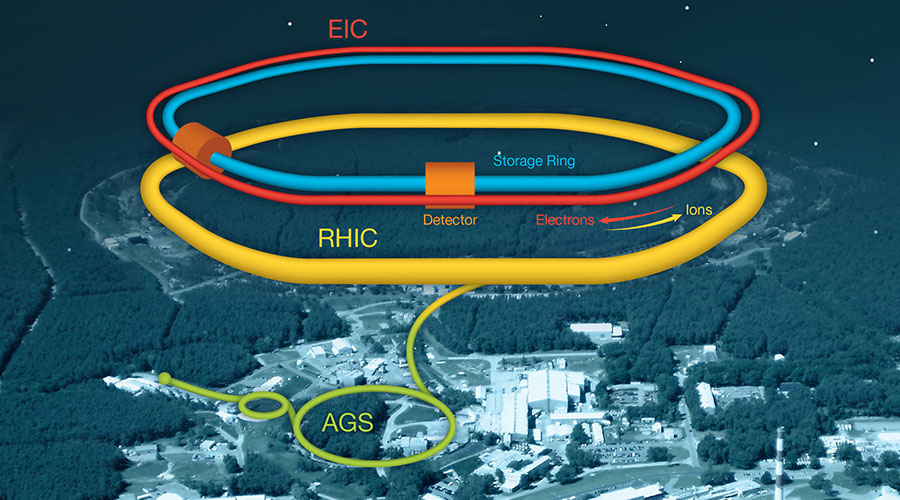By Mitch Ambrose | October 13, 2023

Credit: Brookhaven National Laboratory
The planned Electron-Ion Collider at Brookhaven Lab. A new electron accelerator (red) and electron storage ring (blue) will fit inside the tunnel that houses the Relativistic Heavy Ion Collider (yellow).
For the next ten years, two of the highest priorities of the US nuclear physics community are to construct an Electron-Ion Collider (EIC) and to pursue an international campaign to detect the hypothesized process of neutrinoless double beta decay (NDBD). These projects are endorsed in the Long Range Plan for Nuclear Science, published in October by the Nuclear Science Advisory Committee, which reports to the Department of Energy and National Science Foundation.
The plan was produced by a panel of nuclear scientists who spent over a year gathering community input and deciding priorities for research, facility construction, and workforce development. NSAC unanimously approved the plan on Oct. 4; it will now be a guidance document for the agencies and a tool for advocacy with Congress.
The previous iteration of the plan, published in 2015, also ranked the EIC and a hunt for NDBD as top priorities. Significant progress has been made on the EIC since then, with Brookhaven National Lab selected as the host site and preparation for construction underway. The facility is estimated to cost DOE around $2.4 billion to build and would begin operations in about a decade. The collider promises to provide unprecedented insight into the structure of protons, and it would help sustain a workforce capable of building and operating world-class particle accelerator facilities.
Meanwhile, the NDBD campaign remains in the early planning stages. If detected, the decay would indicate the neutrino is its own antiparticle, a discovery which could shed light on fundamental questions, such as why matter is more prevalent than antimatter in the universe. Given how difficult such a decay would be to detect, the plan endorses pursuing three distinct experiment concepts that have been in development: CUPID, nEXO, and LEGEND-1000. The US share of costs across all three experiments could total around $1 billion over ten years, according to a 2021 estimate.
DOE and NSF asked the panel to consider two budget scenarios: constant funding and 2% annual growth above inflation relative to the fiscal year 2022 budget for nuclear physics. The panel later added two more scenarios: 2% annual growth above inflation relative to the fiscal year 2023 budget and growth consistent with the CHIPS and Science Act, which proposes a more ambitious ramp-up.
The panel concludes it’s possible to pursue the EIC and NDBD campaign in parallel even under the 2% growth scenarios, though it would require stretching out the project schedules, reducing operation funds for existing facilities, and deferring work on other potential projects. The plan highlights other proposed projects, too, such as upgrades to the Continuous Electron Beam Accelerator Facility at Jefferson Lab and the recently completed Facility for Rare Isotope Beams at Michigan State University.
The highest overall priority of the plan, ahead of pursuing NDBD and the EIC, is to “capitalize on the extraordinary opportunities for scientific discovery made possible by the substantial and sustained investments of the United States.” This entails continuing “effective operation” of existing national user facilities for nuclear science, increasing the research budget, raising the salaries of graduate students to be commensurate with their cost of living, and expanding efforts “to ensure a safe and respectful [workplace] environment for everyone,” the plan explains.
The plan only briefly discusses the outlook under the constant budget scenario, simply stating it “would sacrifice much of the new opportunities” presented in the report and result in “relinquishing US leadership in key areas of nuclear physics.”
Mitch Ambrose is Director of FYI. Published by the American Institute of Physics since 1989, FYI is a trusted source of science policy news. Sign up for free emails at aip.org/fyi.
©1995 - 2024, AMERICAN PHYSICAL SOCIETY
APS encourages the redistribution of the materials included in this newspaper provided that attribution to the source is noted and the materials are not truncated or changed.
Editor: Taryn MacKinney
November 2023 (Volume 32, Number 11)
Articles in this Issue

